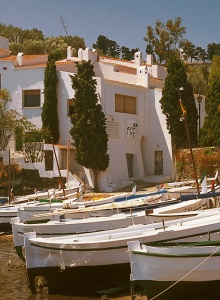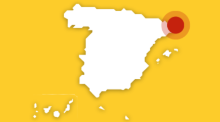Located in the heart of the Cap de Creus peninsula, Cadaqués is one of the most emblematic towns on the Costa Brava of Girona. Its rocky coastline, crossed by beautiful beaches and secluded coves, constitutes one of its main attractions, as well as the incredible landscape that the Cap de Creus Natural Park offers.
At the bottom of the bay of Cadaqués is its historic center, with a Mediterranean air and deep seafaring flavor. A source of inspiration for internationally renowned painters and artists for decades, today this centre enjoys an intense cultural life, as evidenced by its numerous museums and art galleries, including the Salvador Dalí House-Museum. Cadaqués will be the ideal starting point to discover the rest of the Alt Empordà region, full of historic towns, unusual natural spaces and abundant archaeological sites.
The Costa Brava is the most northerly stretch of coastline in Catalonia and one of the most beautiful in Spain. In the heart of the Cape de Creus is Cadaqués, a town framed by the unusual natural landscape formed by the rugged mountain ranges that cross the county of Alt Empordà until they become cliffs that drop off into the sea.This beautiful town with seafaring roots has excellent beaches and quiet coves with transparent waters that, together with an unbeatable tourist infrastructure, attract all those looking for a place to enjoy the sun and the sea. Its status as a natural harbour and the quality of its seabed offer the best conditions for all kinds of water sports and activities, such as diving, sailing and windsurfing.
The historic center
At the end of the bay of Cadaqués stands the narrow network of cobbled streets and white houses that make up its historical quarter. The image of the Church of Santa María stands out above the profile of the town, a carefully restored building with a white façade that houses a magnificent baroque altarpiece. For its part, modernist architecture has left its peculiar mark on some of the most notable buildings in the city, such as the Casa Serinyena.During the first decades of the 20th century, the town became an important European cultural center. Numerous avant-garde artists, including Picasso, Chagall and Klein, found their particular source of inspiration in this beautiful corner of Girona.However, it was Salvador Dalí who gave Cadaqués international fame, since the great painter spent long periods of time in this town during his childhood, and also established his residence there. Dalí's house-museum, located in front of the Bay of Port Lligat, to the north of the town, allows you to discover part of the meticulous work of this master of Surrealism.The great cultural offering that Cadaqués has goes through its numerous museums and art galleries, such as the Municipal Art Museum, which exhibits works by artists who maintained a close connection with Cadaqués, without forgetting the now traditional International Music Festival, which is held annually in the church of Santa María.
Cuisine and countryside
The rich gastronomic tradition of the Empordà is well represented in Cadaqués, since in this town you can taste some of the region's specialties. Dishes such as fish suquet, rice casserole or cuttlefish with peas demonstrate a genius combination of products from the sea and the countryside. As an accompaniment, the Designation of Origin Ampurdán-Costa Brava produces excellent rosé wines, among which the “novell” wine should be mentioned. Sweet wines and exceptional young, fruity and light red wines are also made.The strategic location of Cadaqués will allow you to discover other towns in the Alt Empordà region. Several kilometres to the north is Colera, a fishing village that has beautiful beaches such as Garvet or Els Morts. Other towns of interest are Llançà, with a lively marina, and El Port de la Selva, where the medieval monastery of Sant Pere de Rodes is located. To the south of Cape Creus is Roses, which preserves vestiges of its ancient citadel (16th century) and Castelló d'Empúries, where the church of Santa María stands out (10th century).Nature lovers will find important protected spaces in this sector of the Costa Brava. In the Gulf of Roses, you can visit the Aiguamolls de l'Empordà Natural Park, an important ecological reserve (especially for waterfowl). As for the Cap de Creus Natural Park, it is a one-of-a-kind place from a natural point of view and a clear example of the physiognomy of the Costa Brava.







